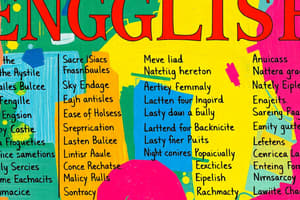Podcast
Questions and Answers
What is the main period associated with Old English?
What is the main period associated with Old English?
- 450-1150 AD (correct)
- 1000-1200 AD
- 1150-1500 AD
- 1500-present
Which authors are known for their contributions to English literature?
Which authors are known for their contributions to English literature?
- William Shakespeare, Jane Austen (correct)
- Leo Tolstoy, Gabriel Garcia Marquez
- F. Scott Fitzgerald, J.K. Rowling
- Mark Twain, Ernest Hemingway
What characterized the grammar of Modern English?
What characterized the grammar of Modern English?
- Standardized vocabulary and grammar (correct)
- Use of double negatives
- Complex sentence structures with heavy inflections
- Strictly phonetic spelling rules
What major influence did the Norman Conquest have on the English language?
What major influence did the Norman Conquest have on the English language?
Which of the following is NOT a feature of English phonetics?
Which of the following is NOT a feature of English phonetics?
How has digital communication affected the use of the English language?
How has digital communication affected the use of the English language?
What does the phrase 'Subject-verb-object' refer to in English grammar?
What does the phrase 'Subject-verb-object' refer to in English grammar?
Which of the following accurately describes the lexicon of the English language?
Which of the following accurately describes the lexicon of the English language?
Flashcards are hidden until you start studying
Study Notes
Overview of the English Language
- Language Family: West Germanic, part of the Indo-European family.
- Global Status: Widely spoken as a first and second language; considered a global lingua franca.
Historical Development
- Old English (450-1150 AD): Influenced by Anglo-Saxon culture; major texts include Beowulf.
- Middle English (1150-1500 AD): Emerged post-Norman Conquest; marked by French and Latin influences; notable work: Chaucer's The Canterbury Tales.
- Modern English (1500-present): Standardized in the 18th century; characterized by diverse vocabulary and grammar.
Key Features
- Alphabet: 26 letters, Latin script.
- Phonetics: Vowel and consonant sounds; significant variety in accents and dialects.
- Grammar:
- Subject-verb-object (SVO) sentence structure.
- Tenses: past, present, future; use of auxiliary verbs.
- Noun phrases: subject, object, and modifiers.
Vocabulary
- Lexicon: Rich and diverse, derived from Latin, French, Germanic, and other languages.
- Word Formation: Includes compounding, affixation, and conversion.
- Idioms and Phrasal Verbs: Expressions that cannot be understood literally.
Dialects and Varieties
- British English vs. American English: Distinctions in spelling, pronunciation, and vocabulary (e.g., "colour" vs. "color").
- Regional Dialects: Scottish, Irish, Australian, and Indian English variations.
Literature
- Genres: Poetry, drama, fiction, and non-fiction.
- Notable Authors: William Shakespeare, Jane Austen, Charles Dickens, Virginia Woolf.
Rhetoric and Composition
- Persuasive Techniques: Ethos, pathos, logos.
- Essay Structure: Introduction, body, conclusion; importance of thesis statements.
Language Acquisition
- First Language Acquisition: Natural learning in early childhood.
- Second Language Learning: Methods include immersion, formal education, and practice.
Contemporary Use
- Digital Communication: Influence of texting, social media, and globalization.
- Slang and Colloquialisms: Evolution of informal language used in different contexts.
Importance of English
- Education and Employment: Essential for academic success and career opportunities globally.
- Cultural Influence: Dominates media, entertainment, and technology.
Overview of the English Language
- The English language is a West Germanic language, part of the Indo-European language family.
- It's widely spoken globally as a first and second language, serving as a global lingua franca.
Historical Development
- Old English (450-1150 AD) was heavily influenced by Anglo-Saxon culture, with notable works like the epic poem "Beowulf."
- Middle English (1150-1500 AD), emerging after the Norman Conquest, was marked by French and Latin influences. Chaucer's "The Canterbury Tales" exemplifies Middle English writings.
- Modern English (1500-present), standardized in the 18th century, is characterized by a diverse vocabulary and grammatical rules.
Key Features
- English uses the 26-letter Latin alphabet for writing.
- Its sounds are represented through phonetics, and variations in pronunciation create accents and dialects.
- The core sentence structure in English follows the Subject-Verb-Object (SVO) order.
- Tense systems (past, present, future) rely on auxiliary verbs, further defining the verb's action.
- Modifiers enrich nouns within noun phrases to provide more detail about the subject, object, or other elements.
Vocabulary
- English boasts a vast lexicon, drawing words from numerous sources: Latin, French, Germanic and other languages.
- New words are formed through diverse methods: compounding, affixation (adding prefixes and suffixes), and conversion (shifting a word's grammatical function).
- Idioms and phrasal verbs are unique expressions with meanings that can't be deduced from their individual components.
Dialects and Varieties
- British English and American English exhibit differences in spelling, pronunciation, and vocabulary (e.g. "colour" vs. "color").
- Regional dialects exist within these broad categories, including variations in Scottish, Irish, Australian, and Indian English.
Literature
- English literature spans a vast array of genres, encompassing poetry, drama, fiction, and non-fiction.
- Notable authors include Shakespeare, Jane Austen, Charles Dickens, and Virginia Woolf, each representing different literary movements and styles.
Rhetoric and Composition
- Persuasive techniques in rhetoric rely on ethos, pathos, and logos to effectively convey arguments.
- When writing essays, the traditional structure includes an introduction, body paragraphs, and a conclusion. Forming a clear thesis statement is crucial for presenting the argument effectively.
Language Acquisition
- First language acquisition refers to the natural learning process of a child's native language.
- Second language learning encompasses various approaches: immersion in the language, formal education in language classes, and regular practice.
Contemporary Use
- The digital age has profoundly influenced English usage; texting, social media, and globalization impact communication patterns.
- Contemporary language includes slang and colloquialisms, which are informal expressions used in specific contexts.
Importance of English
- Proficiency in English is vital globally for academic success and career opportunities.
- English dominates media, impacting entertainment and technological industries, further solidifying its cultural influence.
Studying That Suits You
Use AI to generate personalized quizzes and flashcards to suit your learning preferences.




